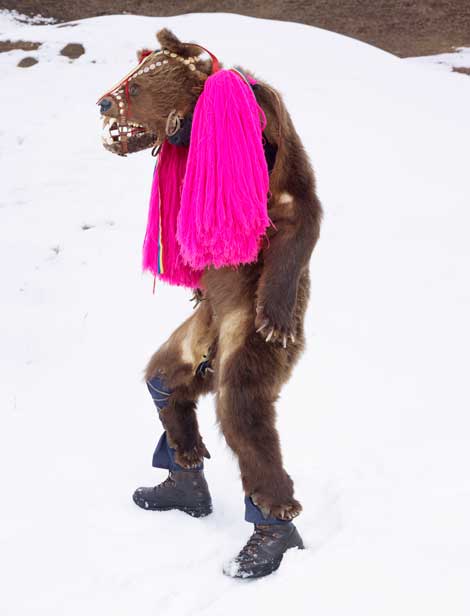“Charles Freger at Fotomuseum Antwerp,” Artillery Magazine. Vol. 7 Issue 6. Sept/Oct. 2013. 55.
In 2010 the French photographer began traveling to rural farming villages in over a dozen European countries to document people, pictured mostly alone, out in the wilderness, wearing homemade costumes used in celebratory events marking the solstices, the harvest and coming of winter—calendar dates that, after millennia and the “civilizing” of Pagan populations, eventually mutated into Christmas and Easter. The costumes referencing human/animal hybrids are cobbled-together, yet visually astounding.
In one characteristic photo, Peluche; Evolène, Switzerland (2013), a figure in a snowy landscape wears waterproof pants and mounds of animal pelts piled high like a football player’s shoulder pads. His tiny badger face and gigantic lumbering body creates a funny juxtaposition. Dozens of other creatures in more framed photos create a similarly strange cast of characters. There are awkward straw men, farmers with ballooning marshmallow bodies, demons on parade, and totemic figures covered in hair. Fréger photographs each subject like a fascinated anthropologist, collecting documents of the strange and unusual from distant lands. But these subjects are closer than they seem, some living just beyond the city. It is Fréger’s ability to render the “rural European” into a cultural oddity that creates a startling, perhaps unintentional, critique, dependent on the exhibition’s position within the museum’s larger curatorial framework.
One floor down from “Wilder Mann” was the exhibition “Camera Exotica: Selections from the FoMu Museum,” an exhibition filled with an abundance of unsurprising photographs of indigenous peoples from the Congo, India and other “distant lands,” all taken before the 1960s. While this exhibit did pay lip service to the racism of European colonialism, it did so only in short wall texts, re-inscribing colonized populations as exotic “others.” Such a display immediately reminds one of Hal Foster’s observation that the under the Eurocentric anthropological gaze, “Relationships between parts of the world…can be understood as temporal relations…. ‘Over there’ became ‘back then.’” In this schema, the Western explorer sees remote cultures as facilitating a symbolic “return” to the “primitive.”
Fréger’s photos in proximity to their 20th century “exotic” counterparts create an extenuation of Foster’s analysis, a complication of European identity in relation to an imagined exotic other. If we see Fréger’s work as collapsing the physical space between the civilized and uncivilized, then does this also disrupt the temporal space of “now” and “then”? In Fréger’s photos the European is made “primitive” through costuming like his colonized counterpart. While this contrast is perhaps superficial, in no way speaking to the destructive legacies of exploitation and racism that colonization left in its wake, perhaps a show like Fréger’s can, if only momentarily, deconstruct the European mythology of cultural supremacy, which is itself a truly terrifying monster.
©2024 Tucker Neel. All rights reserved.



